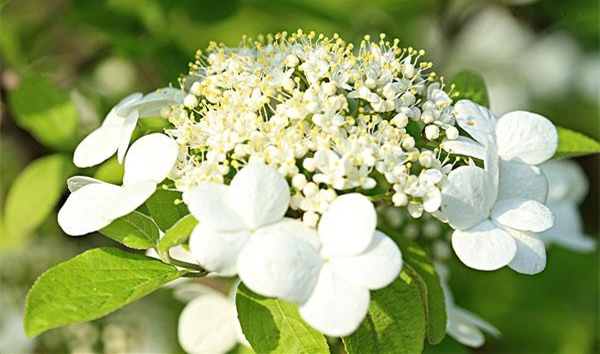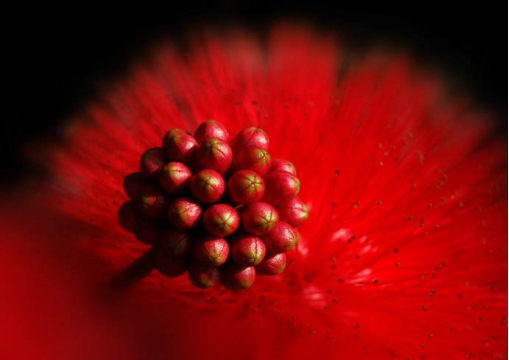Matters needing attention in breeding Qionghua
When sowing and breeding, we should carefully select the substrate, and the factors we need to consider are whether it is fertile and whether the drainage performance is good or not. And we should also do it in a semi-shaded environment and be careful not to be exposed to too much light. The time of reproduction is better in the early spring, so the survival rate is higher. Apply more fertilizer and water in time.

Has everyone learned the breeding method of Qionghua? I hope this article can be helpful to all of you!
What kind of flower is Qionghua? Culture methods and matters needing attention of Qionghua
Qionghua, also known as Jueight Immortals, Woody Hydrangea, etc., is a semi-evergreen shrub of the genus Ninjuriaceae, with flowers as large as jade pots, surrounded by eight large five-petal flowers in a week, surrounded by a white pearl-like flower in the middle, surrounded by a mass of butterfly-like stamens, like butterflies playing beads in the breeze, and dancing like eight Immortals, immortal and attractive. Let's take a look at the breeding methods and matters needing attention of Qionghua.
The growth habits of Qionghua
Qionghua likes light, slightly resistant to shade, likes warm and humid climate, is more hardy, and is suitable to grow in fertile, moist and well-drained soil. More hardy, can adapt to the general soil, good born in moist and fertile places. The growth is exuberant, the germination ability and tillering ability are strong, and the seeds have the habit of germination every other year. Produced in southern Jiangsu, western Anhui, Zhejiang, northwest Jiangxi, western Hubei and southern Hunan. Born in hills, under forests on hillsides or in thickets. Gardens are also often cultivated.
The Propagation method of Qionghua
1. Sowing: Qionghua commonly used seeds are propagated, collected in November, stacked and ripe, washed, stratified at low temperature to sow in the following spring, and covered with slightly thicker soil and covered with grass. In June of that year, some sprouted and unearthed, at this time can uncover the grass to shade, leave the bed for 2 years to change the bed for planting, 4-5 years for transplanting for garden beautification.
2. Grafting: Qionghua is grafted at the beginning of March (before the bud sprouts), take the branches of the mother tree that can blossom, cut off a section about 5 cm long as the scion, leave the top bud is more ideal, generally use the high grafting method. Place in shade after grafting, wait for the buds of the scion to sprout leaves, and then directly put in the sun, it can blossom in the first year after survival.
Culture methods of Qionghua
1. Soil: Qionghua has strong adaptability, sandy soil, clay and general soil can be cultivated, and the roots of seedlings cultivated with sandy soil are well developed.
2. Transplanting: Qionghua transplanting is easy to survive, which is carried out before germination in early spring, and the semi-overcast environment is the better. attention should be paid to fertilizer and water management after survival.
3. Fertilization: Qionghua should be fertilized with thin fertilizer frequently, leaf yellow can be sprayed with 1max 1000 ferrous sulfate solution, and should be fertilized once after flowering.
4. Pruning: the main branch of Qionghua is easy to sprout and grow, which disturbs the shape of the tree. it can be pruned properly after flowering, and the tip of the overgrown branch is cut off in summer to take the shape of the whole plant.
5. Diseases and insect pests: Qionghua leaves have more fur and are generally not easy to be harmed by diseases and insect pests, but they usually need to be sprayed with Bordeaux solution during the plum rain season.
Points for attention of Qionghua
The main results are as follows: 1. Qionghua has strong adaptability and replenishes nitrogen, phosphorus and potassium fertilizer according to the principle of thin fertilizer and frequent application during the growth period.
2. Qionghua family potted plants can choose the method of sowing, or choose seedlings to plant directly.
3. Qionghua generally chooses soil balls in spring or late autumn to plant, which can improve the survival rate.
Culture methods and matters needing attention of Qionghua
Sowing method of Qionghua
The sowing time of Qionghua is usually before and after Ching Ming Festival. The seeds harvested the previous year are taken out, the outer hard shell is removed, soaked in warm water for 24 hours, and then sowed until the shell softens. Note that it is difficult for untreated seeds to emerge after sowing.
After sowing the seeds, the seedlings can generally emerge in about 1 month, and the first leaf of the seedlings can be properly shaded. It is best not to see the light at noon, lest the water evaporates too quickly, causing the seedlings to wilt.
If it is often found that the leaves are curly, but recover in the evening, it means that the weather is dry and moisture is insufficient, and water should be sprinkled frequently during the day to increase air humidity.
The pruning method of Qionghua
Pruning is the most important step in the process of Qionghua flower cultivation.
Every year, after the remaining flowers fade, the new flower buds differentiate. In March of the following year, the buds began to grow. Therefore, it is necessary to make a short cut after the flower fade, to shorten the branches that grow too fast, so as to avoid exposing the branches below as Qionghua grows.
With the continuous growth of Qionghua, the branches will gradually age and be re-cut at the right time. Keep 50 centimeters of stout branches, and cut off all the remaining crown branches to promote the germination of new branches.
Prevention and control of diseases and insect pests of Qionghua
The leaves of Qionghua are often yellowed in the process of culture. Pay attention to the timely supplement of phosphorus and potassium fertilizer and spray ferrous sulfate solution once a week.
The leaves of Qionghua are covered with fur and are generally free from insect pests. But bacteria can cling to the leaves, especially in rainy seasons. So once a month to spray Bordeaux liquid, often ventilated.
Matters needing attention in the culture of Qionghua
Qionghua has developed root system and strong adaptability. during the growth period, nitrogen, phosphorus and potassium fertilizer is supplemented according to the principle of frequent application of thin fertilizer.
Family potted Qionghua can choose the method of sowing, or choose seedlings to plant directly. Generally choose to plant soil balls in spring or late autumn, which can improve the survival rate.
- Prev

Culture methods of Qionghua
The suitable growth temperature of Qionghua is between 15 and 30 ℃. It is a kind of plant that likes shade and tolerates shade, and has strong cold tolerance, so it is best to plant it in slightly acidic and neutral soil for cooling by spraying water in summer.
- Next

Matters needing attention in the Culture of Zhu tasseled Flower
The plants that trim the Zhu tasseled flowers grow very tall and begin to be pruned when the young trees are up to 2 meters high. The main branches of Zhu tasseled flowers can be cut off to promote new branches and make the crown fuller. At ordinary times, we should pay attention to pruning the plant type and cut off the extra side branches and unnecessary new buds.
Related
- Fuxing push coffee new agricultural production and marketing class: lack of small-scale processing plants
- Jujube rice field leisure farm deep ploughing Yilan for five years to create a space for organic food and play
- Nongyu Farm-A trial of organic papaya for brave women with advanced technology
- Four points for attention in the prevention and control of diseases and insect pests of edible fungi
- How to add nutrient solution to Edible Fungi
- Is there any good way to control edible fungus mites?
- Open Inoculation Technology of Edible Fungi
- Is there any clever way to use fertilizer for edible fungus in winter?
- What agents are used to kill the pathogens of edible fungi in the mushroom shed?
- Rapid drying of Edible Fungi

